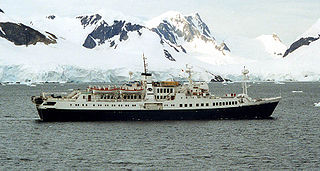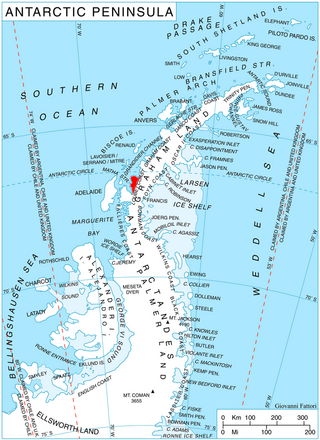Related Research Articles

Thurston Island is a largely ice-covered, glacially dissected island, 135 nautical miles long and 55 nautical miles wide, lying between Amundsen Sea and Bellingshausen Sea a short way off the northwest end of Ellsworth Land, Antarctica. The island is separated from the mainland by Peacock Sound, which is occupied by the west portion of Abbot Ice Shelf.
The Possession Islands are a group of small islands and rocks extending over an area of about 7 nautical miles, lying in the western part of the Ross Sea, lying 5 nautical miles south-east of Cape McCormick, in Victoria Land, Antarctica. The Possession Islands were named by Captain James Clark Ross, Royal Navy, in commemoration of the planting of the British flag here on January 12, 1841.
The Trojan Range is a mountain range rising to 2,760 metres (9,055 ft), extending northward from Mount Francais along the east side of Iliad Glacier, Anvers Island, in the Palmer Archipelago of the British Antarctic Territory. It was surveyed by the Falkland Islands Dependencies Survey (FIDS) in 1955 and named by the UK Antarctic Place-Names Committee (UK-APC) for the Trojans, one of the opposing sides in the Trojan War in Homer's Iliad.

Ulu Peninsula is that portion of James Ross Island northwest of the narrow neck of land between Rohss Bay and Croft Bay, extending from Cape Obelisk to Cape Lachman, in Antarctica.
The Duroch Islands are a group of islands and rocks which extend over an area of about 3 nautical miles, centred about 1 nautical mile off Cape Legoupil on the north coast of Trinity Peninsula, Antarctica. The islands are close to Chile's Base General Bernardo O'Higgins Riquelme at Cape Legoupil.
Prioress Island is a narrow island lying 0.5 nautical miles (0.9 km) east of Host Island in the Wauwermans Islands, in the Wilhelm Archipelago. Shown on an Argentine government chart of 1954. Named by the United Kingdom Antarctic Place-Names Committee (UK-APC) in 1958 after one of the characters in Geoffrey Chaucer's Canterbury Tales.
The Bayard Islands are a small group of islands lying 1.6 km (1 mi) northeast of Cape Willems, off the west coast of Graham Land. They were charted by the Belgian Antarctic Expedition under Gerlache, 1897–99, and named by the UK Antarctic Place-Names Committee in 1960 for Hippolyte Bayard, a French civil servant who, in 1839, independently invented a photographic process for obtaining direct positives on paper.
Knight Island is an island 1.5 nautical miles (3 km) long, lying 1 nautical mile (2 km) west of Reeve Island in the Wauwermans Islands, in the Wilhelm Archipelago, Antarctica. The island was shown on an Argentinian government chart of 1950. It was named by the UK Antarctic Place-Names Committee in 1958 after The Knight, one of the characters in Chaucer's The Canterbury Tales.
Guido Island is an island lying 1 nautical mile (2 km) northeast of Prioress Island in the Wauwermans Islands, in the Wilhelm Archipelago, Antarctica. It was shown on an Argentine government chart of 1950; the name "Isla Guido Spano" appears on a 1957 chart and is for Carlos Guido Spano (1829–1918), a famous Argentine poet.
Dobrowolski Island is a small island which lies close to the east coast of Anvers Island, 3 nautical miles (6 km) southwest of Ryswyck Point, in the Palmer Archipelago. It was charted in 1927 by Discovery Investigations personnel on the Discovery, who gave the name "Astrolabe Island". To avoid duplication, the name was changed in 1958 by the UK Antarctic Place-Names Committee, and the island is now named after Antoni B. Dobrowolski, assistant meteorologist of the Belgian Antarctic Expedition which explored this area in 1898.

Paradise Harbour is a wide embayment behind Lemaire Island and Bryde Island, indenting the west coast of Graham Land, Antarctica, between Duthiers Point and Leniz Point. The name was first applied by whalers operating in the vicinity and was in use by 1920.
Cape Errera is a cape which forms the southwest end of Wiencke Island, in the Palmer Archipelago. It was discovered by the Belgian Antarctic Expedition, 1897–1899, and named by Gerlache for Leo Errera, Paul Errera, and Madame M. Errera, contributors to the expedition.
Friar Island is an island lying immediately northeast of Manciple Island in the Wauwermans Islands, in the Wilhelm Archipelago. It was shown on an Argentine government chart of 1952, but not named. It was named by the UK Antarctic Place-Names Committee in 1958 after The Friar, one of the characters in Geoffrey Chaucer's The Canterbury Tales.
Miethe Glacier is a glacier 3 nautical miles (6 km) long, flowing northwest into Gerlache Strait to the south of Mount Banck, on the west coast of Graham Land, Antarctica. The glacier appears on an Argentine government chart of 1952. It was named by the UK Antarctic Place-Names Committee in 1960 for Adolf Miethe, a German chemist who introduced the first panchromatic emulsion for photographic plates in 1903.
Loaf Rock is a rock lying 3 nautical miles (6 km) west of Biscoe Point, off the southwest coast of Anvers Island in the Palmer Archipelago, Antarctica. It was surveyed by the British Naval Hydrographic Survey Unit in 1956–57, and was so named by the UK Antarctic Place-Names Committee in 1958 because the rock is shaped like a flat loaf of bread.

McCance Glacier is the 30-km long and 5 km wide glacier draining the Hutchison Hill area on the west slopes of Avery Plateau on Loubet Coast in Graham Land, Antarctica. It flows north-northwestwards along the west side of Osikovo Ridge, Kladnitsa Peak and Rubner Peak and enters Darbel Bay.
Manciple Island is an island lying between Reeve Island and Host Island in the Wauwermans Islands, in the Wilhelm Archipelago of Antarctica. It was shown on an Argentine government chart of 1952. The island was named by the UK Antarctic Place-Names Committee in 1958 after the Manciple, one of the characters in Geoffrey Chaucer's The Canterbury Tales.
Thomas Cove is the cove south of Haigh Point, Danco Coast. It was first surveyed by the Falkland Islands Dependencies Survey (FIDS) in 1956–57. The cove was named in association with Haigh Point, by the United Kingdom Antarctic Place-Names Committee (UK-APC) in 1985. It was named after Joan Ena Thomas, who was the personal assistant to the Secretary of the UK-APC Polar Regions Section at the Foreign and Commonwealth Office, from 1948 to 1962.
The Kershaw Peaks are a group of five main peaks, the highest at 820 metres (2,700 ft), standing west of the mouth of Miethe Glacier on the west coast of Graham Land, Antarctica. They were shown on an Argentine government chart of 1952, and were named by the UK Antarctic Place-Names Committee in 1960 for Dennis Kershaw of the Falkland Islands Dependencies Survey, assistant surveyor at the Arthur Harbour station in 1956 and at the Danco Island station in 1957.
Reeve Island is an island 1.5 nautical miles long, lying between Knight and Friar islands in the Wauwermans Islands, in the Wilhelm Archipelago. Shown on an Argentine government chart of 1950. Named by the United Kingdom Antarctic Place-Names Committee (UK-APC) in 1958 after one of the characters in Chaucer's Canterbury Tales.
References
- ↑ "Host Island". Geographic Names Information System . United States Geological Survey, United States Department of the Interior . Retrieved 28 June 2012.
![]() This article incorporates public domain material from "Host Island". Geographic Names Information System . United States Geological Survey.
This article incorporates public domain material from "Host Island". Geographic Names Information System . United States Geological Survey.